Dāiyah
Evidence
Some Proofs for the Truth of Islam
Allah (سبحانه و تعالى) supported His last Prophet Muhammad (صلی اللہ علیہ وسلم) with many miracles and much evidence which proved that he is a true Prophet sent by Allah (سبحانه و تعالى). Also, Allah (سبحانه و تعالى) supported His last revealed book, the Holy Quran, with many miracles that prove that this Quran is the literal word of Allah (سبحانه و تعالى), revealed by Him, and that it was not authored by any human being. This chapter discusses some of this evidence.
(1) The Scientific Miracles in the Holy Quran
The Quran is the literal word of Allah (سبحانه و تعالى), which He revealed to His Prophet Muhammad (صلی اللہ علیہ وسلم) through the Angel Gabriel. It was memorized by Prophet Muhammad (صلی اللہ علیہ وسلم), who then dictated it to his Companions. They, in turn, memorized it, wrote it down, and reviewed it with the Prophet Muhammad (صلی اللہ علیہ وسلم). Moreover, the Prophet Muhammad (صلی اللہ علیہ وسلم) reviewed the Quran with the Angel Gabriel once each year and twice in the last year of his life. From the time the Quran was revealed, until this day, there has always been a huge number of Muslims who have memorized all of the Quran, letter by letter. Some of them have even been able to memorize all of the Quran by the age of ten. Not one letter of the Quran has been changed over the centuries.
The Quran, which was revealed fourteen centuries ago, mentioned facts only recently discovered or proven by scientists. This proves without doubt that the Quran must be the literal word of Allah (سبحانه و تعالى), revealed by Him to the Prophet Muhammad (صلی اللہ علیہ وسلم), and that the Quran was not authored by Prophet Muhammad (صلی اللہ علیہ وسلم) or by any other human being. This also proves that Prophet Muhammad (صلی اللہ علیہ وسلم) is truly a prophet sent by Allah (سبحانه و تعالى). It is beyond reason that anyone fourteen hundred years ago would have known these facts discovered or proven only recently with advanced equipment and sophisticated scientific methods. Some examples follow.
A) The Quran on Human Embryonic Development:
In the Holy Quran, Allah (سبحانه و تعالى) speaks about the stages of man’s embryonic development:
We created man from an extract of clay. Then We made him as a drop in a place of settlement, firmly fixed. Then We made the drop into an alaqah (leech, suspended thing, and blood clot), then We made the alaqahinto a mudghah (chewed substance)…
(Quran, 23:12-14)
Literally, the Arabic word alaqah has three meanings: (1) leech, (2) suspended thing, and (3) blood clot.
In comparing a leech to an embryo in the alaqah stage, we find similarity between the two2 as we can see in figure 1. Also, the embryo at this stage obtains nourishment from the blood of the mother, similar to the leech, which feeds on the blood of others.
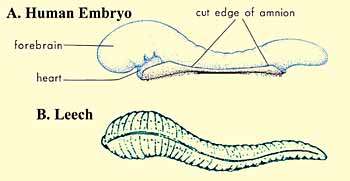
Figure 1: Drawings illustrating the similarities in appearance between a leech and a human embryo at thealaqah stage. (Leech drawing from Human Development as Described in the Quran and Sunnah, Moore and others, p. 37, modified from Integrated Principles of Zoology, Hickman and others. Embryo drawing from The Developing Human, Moore and Persaud, 5th ed., p. 73.)
The second meaning of the word alaqah is “suspended thing.” This is what we can see in figures 2 and 3, the suspension of the embryo, during the alaqah stage, in the womb of the mother.
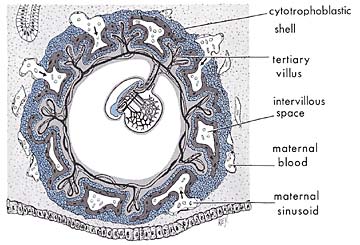
Figure 2: We can see in this diagram the suspension of an embryo during the alaqah stage in the womb (uterus) of the mother. (The Developing Human, Moore and Persaud, 5th ed., p. 66.)
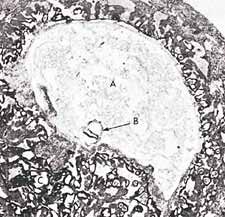
Figure 3: In this photomicrograph, we can see the suspension of an embryo (marked B) during the alaqah stage (about 15 days old) in the womb of the mother. The actual size of the embryo is about 0.6 mm. (The Developing Human, Moore, 3rd ed., p. 66, from Histology, Leeson and Leeson.)
The third meaning of the word alaqah is “blood clot.” We find that the external appearance of the embryo and its sacs during the alaqah stage is similar to that of a blood clot. This is due to the presence of relatively large amounts of blood present in the embryo during this stage (see figure 4). Also during this stage, the blood in the embryo does not circulate until the end of the third week. Thus, the embryo at this stage is like a clot of blood.
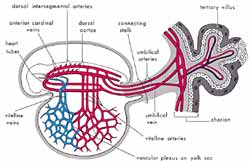
Figure 4: Diagram of the primitive cardiovascular system in an embryo during the alaqah stage. The external appearance of the embryo and its sacs is similar to that of a blood clot, due to the presence of relatively large amounts of blood present in the embryo. (The Developing Human, Moore, 5th ed., p. 65.)
So the three meanings of the word alaqah correspond accurately to the descriptions of the embryo at the alaqah stage.
The next stage mentioned in the verse is the mudghah stage. The Arabic word mudghah means “chewed substance.” If one were to take a piece of gum and chew it in his or her mouth and then compare it with an embryo at the mudghah stage, we would conclude that the embryo at the mudghah stage acquires the appearance of a chewed substance. This is because of the somites at the back of the embryo that “somewhat resemble teethmarks in a chewed substance.” (see figures 5 and 6).
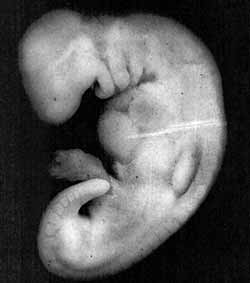
Figure 5: Photograph of an embryo at the mudghah stage (28 days old). The embryo at this stage acquires the appearance of a chewed substance, because the somites at the back of the embryo somewhat resemble teeth marks in a chewed substance. The actual size of the embryo is 4 mm. (The Developing Human, Moore and Persaud, 5th ed., p. 82, from Professor Hideo Nishimura, Kyoto University, Kyoto, Japan.)
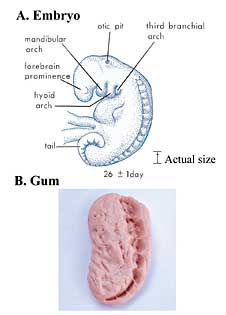
Figure 6: When comparing the appearance of an embryo at themudghah stage with a piece of gum that has been chewed, we find similarity between the two. A) Drawing of an embryo at the mudghah stage. We can see here the somites at the back of the embryo that look like teeth marks. (The Developing Human, Moore and Persaud, 5th ed., p. 79.)B) Photograph of a piece of gum that has been chewed.
How could Prophet Muhammad (صلی اللہ علیہ وسلم) have possibly known all this 1400 years ago, when scientists have only recently discovered this using advanced equipment and powerful microscopes which did not exist at that time? Hamm and Leeuwenhoek were the first scientists to observe human sperm cells (spermatozoa) using an improved microscope in 1677 (more than 1000 years after Prophet Muhammad (صلی اللہ علیہ وسلم)). They mistakenly thought that the sperm cell contained a miniature preformed human being that grew when it was deposited in the female genital tract.
Professor Emeritus Keith L. Moore is one of the world’s most prominent scientists in the fields of anatomy and embryology and is the author of the book entitled The Developing Human, which has been translated into eight languages. This book is a scientific reference work and was chosen by a special committee in the United States as the best book authored by one person. Dr. Keith Moore is Professor Emeritus of Anatomy and Cell Biology at the University of Toronto, Toronto, Canada. There, he was Associate Dean of Basic Sciences at the Faculty of Medicine and for 8 years was the Chairman of the Department of Anatomy. In 1984, he received the most distinguished award presented in the field of anatomy in Canada, the J.C.B. Grant Award from the Canadian Association of Anatomists. He has directed many international associations, such as the Canadian and American Association of Anatomists and the Council of the Union of Biological Sciences.
In 1981, during the Seventh Medical Conference in Dammam, Saudi Arabia, Professor Moore said: “It has been a great pleasure for me to help clarify statements in the Quran about human development. It is clear to me that these statements must have come to Prophet Muhammad (صلی اللہ علیہ وسلم) from Allah (سبحانه و تعالى), because almost all of this knowledge was not discovered until many centuries later. This proves to me that Prophet Muhammad (صلی اللہ علیہ وسلم) must have been a messenger of Allah (سبحانه و تعالى).”
Consequently, Professor Moore was asked the following question: “Does this mean that you believe that the Quran is the word of Allah (سبحانه و تعالى)?” He replied: “I find no difficulty in accepting this.”
During one conference, Professor Moore stated: “….Because the staging of human embryos is complex, owing to the continuous process of change during development, it is proposed that a new system of classification could be developed using the terms mentioned in the Quran and Sunnah (what Prophet Muhammad (صلی اللہ علیہ وسلم) said, did, or approved of). The proposed system is simple, comprehensive, and conforms with present embryological knowledge. The intensive studies of the Quran andhadeeth (reliably transmitted reports by the Prophet Muhammad (صلی اللہ علیہ وسلم)’s companions of what he said, did, or approved of) in the last four years have revealed a system for classifying human embryos that is amazing since it was recorded in the seventh century A.D. Although Aristotle, the founder of the science of embryology, realized that chick embryos developed in stages from his studies of hen’s eggs in the fourth century B.C., he did not give any details about these stages. As far as it is known from the history of embryology, little was known about the staging and classification of human embryos until the twentieth century. For this reason, the descriptions of the human embryo in the Quran cannot be based on scientific knowledge in the seventh century. The only reasonable conclusion is: these descriptions were revealed to Prophet Muhammad (صلی اللہ علیہ وسلم) from Allah (سبحانه و تعالى). He could not have known such details because he was an illiterate man with absolutely no scientific training.”
B) The Quran on Mountains:
A book entitled Earth is a basic reference textbook in many universities around the world. One of its two authors is Professor Emeritus Frank Press. He was the Science Advisor to former US President Jimmy Carter, and for 12 years was the President of the National Academy of Sciences, Washington, DC. His book says that mountains have underlying roots. These roots are deeply embedded in the ground, thus, mountains have a shape like a peg (see figures 7, 8, and 9).
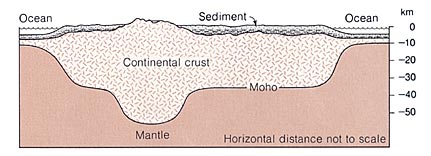
Figure 7: Mountains have deep roots under the surface of the ground. (Earth, Press and Siever, p. 413.)
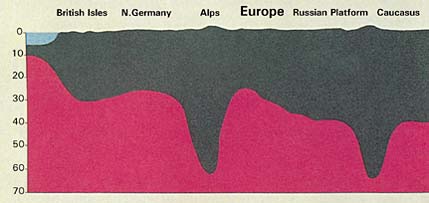
Figure 8: Schematic section. The mountains, like pegs, have deep roots embedded in the ground. (Anatomy of the Earth, Cailleux, p. 220.)

Figure 9: Another illustration shows how the mountains are peg-like in shape, due to their deep roots. (Earth Science, Tarbuck and Lutgens, p. 158.)
This is how the Quran has described mountains. Allah (سبحانه و تعالى) has said in the Quran:
Have We not made the earth as a bed, and the mountains as pegs? (Quran, 78:6-7)
Modern earth sciences have proven that mountains have deep roots under the surface of the ground (see figure 9) and that these roots can reach several times their elevations above the surface of the ground. So the most suitable word to describe mountains on the basis of this information is the word ‘peg,’ since most of a properly set peg is hidden under the surface of the ground. The history of science tells us that the theory of mountains having deep roots was introduced only in the latter half of the nineteenth century.
Mountains also play an important role in stabilizing the crust of the earth. They hinder the shaking of the earth. Allah (سبحانه و تعالى) has said in the Quran:
And He has set firm mountains in the earth so that it would not shake with you… (Quran, 16:15)
Likewise, the modern theory of plate tectonics holds that mountains work as stabilizers for the earth. This knowledge about the role of mountains as stabilizers for the earth has just begun to be understood in the framework of plate tectonics since the late 1960’s.
Could anyone during the time of the Prophet Muhammad (صلی اللہ علیہ وسلم) have known of the true shape of mountains? Could anyone imagine that the solid massive mountain which he sees before him actually extends deep into the earth and has a root, as scientists assert? A large number of books of geology, when discussing mountains, only describe that part which is above the surface of the earth. This is because these books were not written by specialists in geology. However, modern geology has confirmed the truth of the Quranic verses.
C) The Quran on the Origin of the Universe:
The science of modern cosmology, observational and theoretical, clearly indicates that, at one point in time, the whole universe was nothing but a cloud of ‘smoke’ (i.e. an opaque highly dense and hot gaseous composition).1 This is one of the undisputed principles of standard modern cosmology. Scientists now can observe new stars forming out of the remnants of that ‘smoke’ (see figures 10 and 11).
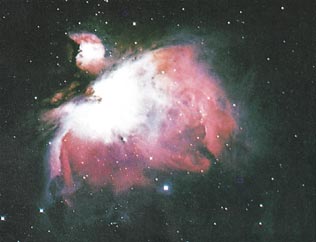
Figure 10: A new star forming out of a cloud of gas and dust (nebula), which is one of the remnants of the ‘smoke’ that was the origin of the whole universe. (The Space Atlas, Heather and Henbest, p. 50.)
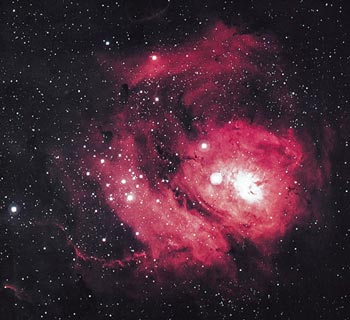
Figure 11: The Lagoon nebula is a cloud of gas and dust, about 60 light years in diameter. It is excited by the ultraviolet radiation of the hot stars that have recently formed within its bulk. (Horizons, Exploring the Universe, Seeds, plate 9, from Association of Universities for Research in Astronomy, Inc.)
The illuminating stars we see at night were, just as was the whole universe, in that ‘smoke’ material. Allah (سبحانه و تعالى) has said in the Quran:
Then He turned to the heaven when it was smoke… (Quran, 41:11)
Because the earth and the heavens above (the sun, the moon, stars, planets, galaxies, etc.) have been formed from this same ‘smoke,’ we conclude that the earth and the heavens were one connected entity. Then out of this homogeneous ‘smoke,’ they formed and separated from each other. Allah (سبحانه و تعالى) has said in the Quran:
Have not those who disbelieved known that the heavens and the earth were one connected entity, then We separated them?… (Quran, 21:30)
Dr. Alfred Kroner is one of the world’s renowned geologists. He is Professor of Geology and the Chairman of the Department of Geology at the Institute of Geosciences, Johannes Gutenberg University, Mainz, Germany. He said: “Thinking where Prophet Muhammad (صلی اللہ علیہ وسلم) came from . . . I think it is almost impossible that he could have known about things like the common origin of the universe, because scientists have only found out within the last few years, with very complicated and advanced technological methods, that this is the case.” Also he said: “Somebody who did not know something about nuclear physics fourteen hundred years ago could not, I think, be in a position to find out from his own mind, for instance, that the earth and the heavens had the same origin.”
D) The Quran on the Cerebrum:
Allah (سبحانه و تعالى) has said in the Quran about one of the evil unbelievers who forbade the Prophet Muhammad (صلی اللہ علیہ وسلم) from praying at the Kaaba:
No! If he does not stop, We will take him by the naseyah (front of the head), a lying, sinful naseyah (front of the head)! (Quran, 96:15-16)
Why did the Quran describe the front of the head as being lying and sinful? Why didn’t the Quran say that the person was lying and sinful? What is the relationship between the front of the head and lying and sinfulness?
If we look into the skull at the front of the head, we will find the prefrontal area of the cerebrum (see figure 12). What does physiology tell us about the function of this area? A book entitled Essentials of Anatomy & Physiologysays about this area, “The motivation and the foresight to plan and initiate movements occur in the anterior portion of the frontal lobes, the prefrontal area. This is a region of association cortex…” Also the book says, “In relation to its involvement in motivation, the prefrontal area is also thought to be the functional center for aggression….”
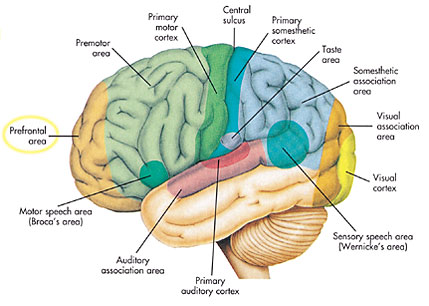
Figure 12: Functional regions of the left hemisphere of the cerebral cortex. The prefrontal area is located at the front of the cerebral cortex. (Essentials of Anatomy & Physiology, Seeley and others, p. 210.) (Click on the image to enlarge it.)
So, this area of the cerebrum is responsible for planning, motivating, and initiating good and sinful behavior and is responsible for the telling of lies and the speaking of truth. Thus, it is proper to describe the front of the head as lying and sinful when someone lies or commits a sin, as the Quran has said,
“…A lying, sinful naseyah (front of the head)!”
Scientists have only discovered these functions of the prefrontal area in the last sixty years, according to Professor Keith L. Moore.
E) The Quran on Seas and Rivers:
Modern Science has discovered that in the places where two different seas meet, there is a barrier between them. This barrier divides the two seas so that each sea has its own temperature, salinity, and density. For example, Mediterranean sea water is warm, saline, and less dense, compared to Atlantic ocean water. When Mediterranean sea water enters the Atlantic over the Gibraltar sill, it moves several hundred kilometers into the Atlantic at a depth of about 1000 meters with its own warm, saline, and less dense characteristics. The Mediterranean water stabilizes at this depth2 (see figure 13).
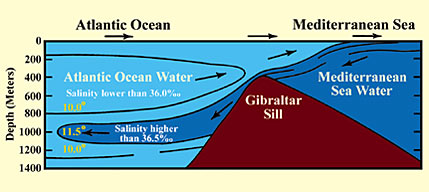
Figure 13: The Mediterranean sea water as it enters the Atlantic over the Gibraltar sill with its own warm, saline, and less dense characteristics, because of the barrier that distinguishes between them. Temperatures are in degrees Celsius (C°). (Marine Geology, Kuenen, p. 43, with a slight enhancement.)
Although there are large waves, strong currents, and tides in these seas, they do not mix or transgress this barrier.
The Holy Quran mentioned that there is a barrier between two seas that meet and that they do not transgress. Allah (سبحانه و تعالى) has said:
He has set free the two seas meeting together. There is a barrier between them. They do not transgress. (Quran, 55:19-20)
But when the Quran speaks about the divider between fresh and salt water, it mentions the existence of “a forbidding partition” with the barrier. Allah (سبحانه و تعالى) has said in the Quran:
He is the one who has set free the two kinds of water, one sweet and palatable, and the other salty and bitter. And He has made between them a barrier and a forbidding partition. (Quran, 25:53)
One may ask, why did the Quran mention the partition when speaking about the divider between fresh and salt water, but did not mention it when speaking about the divider between the two seas?
Modern science has discovered that in estuaries, where fresh (sweet) and salt water meet, the situation is somewhat different from what is found in places where two seas meet. It has been discovered that what distinguishes fresh water from salt water in estuaries is a “pycnocline zone with a marked density discontinuity separating the two layers.” This partition (zone of separation) has a different salinity from the fresh water and from the salt water (see figure 14).
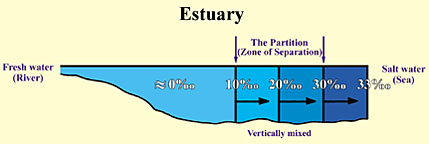
Figure 14: Longitudinal section showing salinity (parts per thousand ‰) in an estuary. We can see here the partition (zone of separation) between the fresh and the salt water. (Introductory Oceanography, Thurman, p. 301, with a slight enhancement.)
This information has been discovered only recently, using advanced equipment to measure temperature, salinity, density, oxygen dissolubility, etc. The human eye cannot see the difference between the two seas that meet, rather the two seas appear to us as one homogeneous sea. Likewise, the human eye cannot see the division of water in estuaries into the three kinds: fresh water, salt water, and the partition (zone of separation).
F) The Quran on Deep Seas and Internal Waves:
Allah (سبحانه و تعالى) has said in the Quran:
Or (the unbelievers’ state) is like the darkness in a deep sea. It is covered by waves, above which are waves, above which are clouds. Darknesses, one above another. If a man stretches out his hand, he cannot see it… (Quran, 24:40)
This verse mentions the darkness found in deep seas and oceans, where if a man stretches out his hand, he cannot see it. The darkness in deep seas and oceans is found around a depth of 200 meters and below. At this depth, there is almost no light (see figure 15). Below a depth of 1000 meters there is no light at all. Human beings are not able to dive more than forty meters without the aid of submarines or special equipment. Human beings cannot survive unaided in the deep dark part of the oceans, such as at a depth of 200 meters.
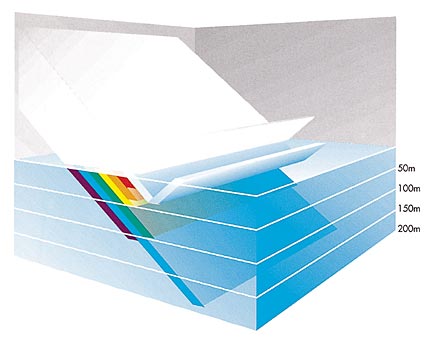
Figure 15: Between 3 and 30 percent of the sunlight is reflected at the sea surface. Then almost all of the seven colors of the light spectrum are absorbed one after another in the first 200 meters, except the blue light. (Oceans, Elder and Pernetta, p. 27.)
Scientists have recently discovered this darkness by means of special equipment and submarines that have enabled them to dive into the depths of the oceans.
We can also understand from the following sentences in the previous verse, “…in a deep sea. It is covered by waves, above which are waves, above which are clouds….”, that the deep waters of seas and oceans are covered by waves, and above these waves are other waves. It is clear that the second set of waves are the surface waves that we see, because the verse mentions that above the second waves there are clouds. But what about the first waves? Scientists have recently discovered that there are internal waves which “occur on density interfaces between layers of different densities.” (see figure 16).
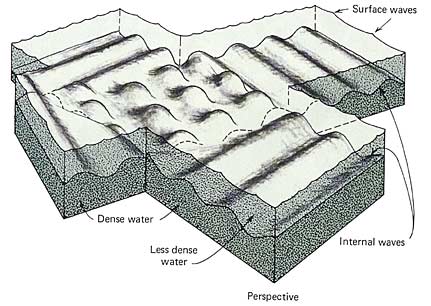
Figure 16: Internal waves at interface between two layers of water of different densities. One is dense (the lower one), the other one is less dense (the upper one). (Oceanography, Gross, p. 204.)
The internal waves cover the deep waters of seas and oceans because the deep waters have a higher density than the waters above them. Internal waves act like surface waves. They can also break, just like surface waves. Internal waves cannot be seen by the human eye, but they can be detected by studying temperature or salinity changes at a given location.
G) The Quran on Clouds:
Scientists have studied cloud types and have realized that rain clouds are formed and shaped according to definite systems and certain steps connected with certain types of wind and clouds.
One kind of rain cloud is the cumulonimbus cloud. Meteorologists have studied how cumulonimbus clouds are formed and how they produce rain, hail, and lightning.
They have found that cumulonimbus clouds go through the following steps to produce rain:
1) The clouds are pushed by the wind: Cumulonimbus clouds begin to form when wind pushes some small pieces of clouds (cumulus clouds) to an area where these clouds converge (see figures 17 and 18).
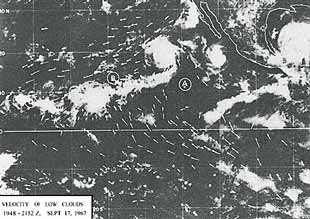
Figure 17: Satellite photo showing the clouds moving towards the convergence areas B, C, and D. The arrows indicate the directions of the wind. (The Use of Satellite Pictures in Weather Analysis and Forecasting, Anderson and others, p. 188.)
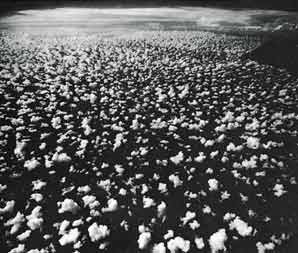
Figure 18: Small pieces of clouds (cumulus clouds) moving towards a convergence zone near the horizon, where we can see a large cumulonimbus cloud. (Clouds and Storms, Ludlam, plate 7.4.)
2) Joining: Then the small clouds join together forming a larger cloud1 (see figures 18 and 19).
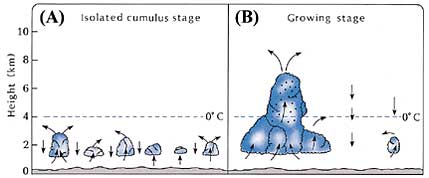
Figure 19: (A) Isolated small pieces of clouds (cumulus clouds). (B) When the small clouds join together, updrafts within the larger cloud increase, so the cloud is stacked up. Water drops are indicated by •. (The Atmosphere, Anthes and others, p. 269.)
3) Stacking: When the small clouds join together, updrafts within the larger cloud increase. The updrafts near the center of the cloud are stronger than those near the edges. These updrafts cause the cloud body to grow vertically, so the cloud is stacked up (see figures 19 (B), 20, and 21). This vertical growth causes the cloud body to stretch into cooler regions of the atmosphere, where drops of water and hail formulate and begin to grow larger and larger. When these drops of water and hail become too heavy for the updrafts to support them, they begin to fall from the cloud as rain, hail, etc.
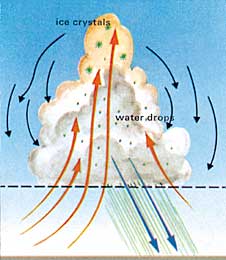
Figure 20: A cumulonimbus cloud. After the cloud is stacked up, rain comes out of it. (Weather and Climate, Bodin, p.123.)
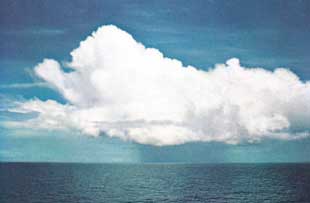
Figure 21: A cumulonimbus cloud. (A Colour Guide to Clouds, Scorer and Wexler, p. 23.)
Allah (سبحانه و تعالى) has said in the Quran:
Have you not seen how Allah (سبحانه و تعالى) makes the clouds move gently, then joins them together, then makes them into a stack, and then you see the rain come out of it… (Quran, 24:43)
Meteorologists have only recently come to know these details of cloud formation, structure, and function by using advanced equipment like planes, satellites, computers, balloons, and other equipment, to study wind and its direction, to measure humidity and its variations, and to determine the levels and variations of atmospheric pressure.
The preceding verse, after mentioning clouds and rain, speaks about hail and lightning:
….And He sends down hail from mountains (clouds) in the sky, and He strikes with it whomever He wills, and turns it from whomever He wills. The vivid flash of its lightning nearly blinds the sight. (Quran, 24:43)
Meteorologists have found that these cumulonimbus clouds, that shower hail, reach a height of 25,000 to 30,000 ft (4.7 to 5.7 miles), like mountains, as the Quran said,“…And He sends down hail from mountains (clouds) in the sky…” (see figure 21 above).
This verse may raise a question. Why does the verse say “its lightning” in a reference to the hail? Does this mean that hail is the major factor in producing lightning? Let us see what the book entitled Meteorology Today says about this. It says that a cloud becomes electrified as hail falls through a region in the cloud of supercooled droplets and ice crystals. As liquid droplets collide with a hailstone, they freeze on contact and release latent heat. This keeps the surface of the hailstone warmer than that of the surrounding ice crystals. When the hailstone comes in contact with an ice crystal, an important phenomenon occurs: electrons flow from the colder object toward the warmer object. Hence, the hailstone becomes negatively charged. The same effect occurs when supercooled droplets come in contact with a hailstone and tiny splinters of positively charged ice break off. These lighter positively charged particles are then carried to the upper part of the cloud by updrafts. The hail, left with a negative charge, falls towards the bottom of the cloud, thus the lower part of the cloud becomes negatively charged. These negative charges are then discharged as lightning. We conclude from this that hail is the major factor in producing lightning.
This information on lightning was discovered recently. Until 1600 AD, Aristotle’s ideas on meteorology were dominant. For example, he said that the atmosphere contains two kinds of exhalation, moist and dry. He also said that thunder is the sound of the collision of the dry exhalation with the neighboring clouds, and lightning is the inflaming and burning of the dry exhalation with a thin and faint fire. These are some of the ideas on meteorology that were dominant at the time of the Quran’s revelation, fourteen centuries ago.
(2) The Great Challenge to Produce One Chapter Like the Chapters of the Holy Quran
Allah (سبحانه و تعالى) has said in the Quran:
And if you are in doubt about what We have revealed (the Quran) to Our worshiper (Prophet Muhammad (صلی اللہ علیہ وسلم) ), then produce a chapter like it, and call your witnesses (supporters and helpers) besides Allah (سبحانه و تعالى) if you are truthful. And if you do not do it, and you can never do it, then fear the Fire (Hell) whose fuel is men and stones. It has been prepared for disbelievers. And give good news (O Prophet Muhammad (صلی اللہ علیہ وسلم)) to those who believe and do good deeds, that for them are gardens (Paradise) in which rivers flow…. (Quran, 2:23-25)
Ever since the Quran was revealed, fourteen centuries ago, no one has been able to produce a single chapter like the chapters of the Quran in their beauty, eloquence, splendor, wise legislation, true information, true prophecy, and other perfect attributes. Also, note that the smallest chapter in the Quran (Chapter 108) is only ten words, yet no one has ever been able to meet this challenge, then or today. Some of the disbelieving Arabs who were enemies of the Prophet Muhammad (صلی اللہ علیہ وسلم) tried to meet this challenge to prove that Prophet Muhammad (صلی اللہ علیہ وسلم) was not a true prophet, but they failed to do so. This failure was despite the fact that the Quran was revealed in their own language and dialect and that the Arabs at the time of Prophet Muhammad (صلی اللہ علیہ وسلم) were a very eloquent people who used to compose beautiful and excellent poetry, still read and appreciated today.
The smallest chapter in the Holy Quran (Chapter 108) is only ten words, yet no one has ever been able to meet the challenge to produce one chapter like the chapters of the Holy Quran.
(3) Biblical Prophecies on the Advent of Prophet Muhammad (صلی اللہ علیہ وسلم), the Prophet of Islam
The Biblical prophecies on the advent of the Prophet Muhammad (صلی اللہ علیہ وسلم) are evidence of the truth of Islam for people who believe in the Bible.
In Deuteronomy 18, Moses stated that Allah (سبحانه و تعالى) told him: “I will raise up for them a prophet like you from among their brothers; I will put my words in his mouth, and he will tell them everything I command him. If anyone does not listen to my words that the prophet speaks in my name, I myself will call him to account.” (Deuteronomy 18:18-19)
From these verses we conclude that the prophet in this prophecy must have the following three characteristics:
- That he will be like Moses.
- That he will come from the brothers of the Israelites, i.e. the Ishmaelites.
- That Allah (سبحانه و تعالى) will put His words in to the mouth of this prophet and that he will declare what Allah (سبحانه و تعالى) commands him.
Let us examine these three characteristics in more depth:
1) A prophet like Moses:
There were hardly any two prophets who were so much alike as Moses and Prophet Muhammad (صلی اللہ علیہ وسلم). Both were given a comprehensive law and code of life. Both encountered their enemies and were victorious in miraculous ways. Both were accepted as prophets and statesmen. Both migrated following conspiracies to assassinate them. Analogies between Moses and Jesus overlook not only the above similarities but other crucial ones as well. These include the natural birth, the family life, and death of Moses and Prophet Muhammad (صلی اللہ علیہ وسلم) but not of Jesus. Moreover Jesus was regarded by his followers as the Son of Allah (سبحانه و تعالى) and not exclusively as a prophet of Allah (سبحانه و تعالى), as Moses and Prophet Muhammad (صلی اللہ علیہ وسلم) were and as Muslims believe Jesus was. So, this prophecy refers to the Prophet Muhammad (صلی اللہ علیہ وسلم) and not to Jesus, because Prophet Muhammad (صلی اللہ علیہ وسلم) is more like Moses than Jesus.
Also, one notices from the Gospel of John that the Jews were waiting for the fulfillment of three distinct prophecies. The first was the coming of Christ. The second was the coming of Elijah. The third was the coming of the Prophet. This is obvious from the three questions that were posed to John the Baptist: “Now this was John’s testimony, when the Jews of Jerusalem sent priests and Levites to ask him who he was. He did not fail to confess, but confessed freely, “I am not the Christ.” They asked him, “Then who are you? Are you Elijah?” He said, “I am not.” “Are you the Prophet?” He answered, “No.” (John 1:19-21). If we look in a Bible with cross-references, we will find in the marginal notes where the words “the Prophet” occur in John 1:21, that these words refer to the prophecy of Deuteronomy 18:15 and 18:18. We conclude from this that Jesus Christ is not the prophet mentioned in Deuteronomy 18:18.
2) From the brothers of the Israelites:
Abraham had two sons, Ishmael and Isaac (Genesis 21). Ishmael became the grandfather of the Arab nation, and Isaac became the grandfather of the Jewish nation. The prophet spoken of was not to come from among the Jews themselves, but from among their brothers, i.e. the Ishmaelites. Prophet Muhammad (صلی اللہ علیہ وسلم), a descendant of Ishmael, is indeed this prophet.
Also, Isaiah 42:1-13 speaks of the servant of Allah (سبحانه و تعالى), His “chosen one” and “messenger” who will bring down a law. “He will not falter or be discouraged till he establishes justice on earth. In his law the islands will put their hope.” (Isaiah 42:4). Verse 11, connects that awaited one with the descendants of Kedar. Who is Kedar? According to Genesis 25:13, Kedar was the second son of Ishmael, the ancestor of the Prophet Muhammad (صلی اللہ علیہ وسلم).
3) Allah (سبحانه و تعالى) will put His words in the mouth of this prophet:
The words of Allah (سبحانه و تعالى) (the Holy Quran) were truly put into Prophet Muhammad (صلی اللہ علیہ وسلم)’s mouth. Allah (سبحانه و تعالى) sent the Angel Gabriel to teach Prophet Muhammad (صلی اللہ علیہ وسلم) the exact words of Allah (سبحانه و تعالى) (the Holy Quran) and asked him to dictate them to the people as he heard them. The words are therefore not his own. They did not come from his own thoughts, but were put into his mouth by the Angel Gabriel. During the life time of Prophet Muhammad (صلی اللہ علیہ وسلم), and under his supervision, these words were then memorized and written by his companions.
Also, this prophecy in Deuteronomy mentioned that this prophet will speak the words of Allah (سبحانه و تعالى) in the name of Allah (سبحانه و تعالى). If we looked to the Holy Quran, we will find that all its chapters, except Chapter 9, are preceded or begin with the phrase,
In the Name of Allah (سبحانه و تعالى), the Most Gracious, the Most Merciful.
Another indication (other than the prophecy inDeuteronomy) is that Isaiah ties the messenger connected with Kedar with a new song (a scripture in a new language) to be sung to the Lord (Isaiah 42:10-11). This is mentioned more clearly in the prophecy of Isaiah: “and another tongue, will he speak to this people” (Isaiah 28:11 KJV). Another related point, is that the Quran was revealed in sections over a span of twenty-three years. It is interesting to compare this with Isaiah 28 which speaks of the same thing, “For it is: Do and do, do and do, rule on rule, rule on rule; a little here, a little there.” (Isaiah 28:10).
Note that Allah (سبحانه و تعالى) has said in the prophecy of Deuteronomy 18, “If anyone does not listen to my words that the prophet speaks in my name, I myself will call him to account.” (Deuteronomy, 18:19). This means that whoever believes in the Bible must believe in what this prophet says, and this prophet is the Prophet Muhammad (صلی اللہ علیہ وسلم).
(4) The Verses in the Quran That Mention Future Events Which Later Came to Pass
One example of the events foretold in the Quran is the victory of the Romans over the Persians within three to nine years after the Romans were defeated by the Persians. Allah (سبحانه و تعالى) has said in the Quran:
The Romans have been defeated in the nearest land (to the Arabian Peninsula), and they, after their defeat, will be victorious within bedd’ (three to nine) years…. (Quran, 30:2-4)
Let us see what history tells us about these wars. A book entitled History of the Byzantine State says that the Roman army was badly defeated at Antioch in 613, and as a result, the Persians swiftly pushed forward on all fronts. At that time, it was hard to imagine that the Romans would defeat the Persians, but the Quran foretold that the Romans would be victorious within three to nine years. In 622, nine years after the Romans’ defeat, the two forces (Romans and Persians) met on Armenian soil, and the result was the decisive victory of the Romans over the Persians, for the first time after the Romans’ defeat in 613.2 The prophecy was fulfilled just as Allah (سبحانه و تعالى) has said in the Quran.
There are also many other verses in the Quran and sayings of the Prophet Muhammad (صلی اللہ علیہ وسلم) that mention future events which later came to pass.
(5) Miracles Performed by the Prophet Muhammad (صلی اللہ علیہ وسلم)
Many miracles were performed by the Prophet Muhammad (صلی اللہ علیہ وسلم) by Allah (سبحانه و تعالى)’s permission. These miracles were witnessed by many people. For example:
- When the unbelievers in Makkah asked the Prophet Muhammad (صلی اللہ علیہ وسلم) to show them a miracle, he showed them the splitting of the moon.
- Another miracle was the flowing of water through Prophet Muhammad (صلی اللہ علیہ وسلم)’s fingers when his companions got thirsty and had no water except a little in a vessel. They came to him and told him that they had no water to make ablution nor to drink except for what was in the vessel. So, Prophet Muhammad (صلی اللہ علیہ وسلم) put his hand in the vessel, and the water started gushing out between his fingers. So, they drank and made ablution. They were one thousand five hundred companions.
There were also many other miracles that were performed by him or which happened to him.
(6) The Simple Life of Prophet Muhammad (صلی اللہ علیہ وسلم)
If we compare the life of Prophet Muhammad (صلی اللہ علیہ وسلم) before his mission as a prophet and his life after he began his mission as a prophet, we will conclude that it is beyond reason to think that Prophet Muhammad (صلی اللہ علیہ وسلم) was a false prophet, who claimed prophethood to attain material gains, greatness, glory, or power.
Before his mission as a prophet, Prophet Muhammad (صلی اللہ علیہ وسلم) had no financial worries. As a successful and reputed merchant, Prophet Muhammad (صلی اللہ علیہ وسلم) drew a satisfactory and comfortable income. After his mission as a prophet and because of it, he became worse off materially. To clarify this more, let us browse the following sayings on his life:
Aa’isha, Prophet Muhammad (صلی اللہ علیہ وسلم)’s wife, said, “O my nephew, we would sight three new moons in two months without lighting a fire (to cook a meal) in the Prophet’s houses.” Her nephew asked, “O Aunt, what sustained you?” She said, “The two black things, dates and water, but the Prophet had some Ansar neighbors who had milk-giving she-camels and they used to send the Prophet some of its milk.”
Sahl Ibn Sa’ad, one of Prophet Muhammad (صلی اللہ علیہ وسلم)’s companions, said, “The Prophet of Allah (سبحانه و تعالى) did not see bread made from fine flour from the time Allah (سبحانه و تعالى) sent him (as a prophet) until he died.”
Aa’isha, Prophet Muhammad (صلی اللہ علیہ وسلم)’s wife, said, “The mattress of the Prophet, on which he slept, was made of leather stuffed with the fiber of the date-palm tree.”
Amr Ibn Al-Hareth, one of Prophet Muhammad (صلی اللہ علیہ وسلم)’s companions, said that when the Prophet died, he left neither money nor anything else except his white riding mule, his arms, and a piece of land which he left to charity.
Prophet Muhammad (صلی اللہ علیہ وسلم) lived this hard life till he died although the Muslim treasury was at his disposal, the greater part of the Arabian Peninsula was Muslim before he died, and the Muslims were victorious after eighteen years of his mission.
Is it possible that Prophet Muhammad (صلی اللہ علیہ وسلم) might have claimed prophethood in order to attain status, greatness, and power? The desire to enjoy status and power is usually associated with good food, fancy clothing, monumental palaces, colorful guards, and indisputable authority. Do any of these indicators apply to Prophet Muhammad (صلی اللہ علیہ وسلم)? A few glimpses of his life that may help answer this question follow.
Despite his responsibilities as a prophet, a teacher, a statesman, and a judge, Prophet Muhammad (صلی اللہ علیہ وسلم) used to milk his goat, mend his clothes, repair his shoes, help with the household work, and visit poor people when they got sick. He also helped his companions in digging a trench by moving sand with them. His life was an amazing model of simplicity and humbleness.
Prophet Muhammad (صلی اللہ علیہ وسلم)’s followers loved him, respected him, and trusted him to an amazing extent. Yet he continued to emphasize that deification should be directed to Allah (سبحانه و تعالى) and not to him personally. Anas, one of Prophet Muhammad (صلی اللہ علیہ وسلم)’s companions, said that there was no person whom they loved more than the Prophet Muhammad (صلی اللہ علیہ وسلم), yet when he came to them, they did not stand up for him because he hated their standing up for him, as other people do with their great people.
Long before there was any prospect of success for Islam and at the outset of a long and painful era of torture, suffering, and persecution of Prophet Muhammad (صلی اللہ علیہ وسلم) and his followers, he received an interesting offer. An envoy of the pagan leaders, Otba, came to him saying, “…If you want money, we will collect enough money for you so that you will be the richest one of us. If you want leadership, we will take you as our leader and never decide on any matter without your approval. If you want a kingdom, we will crown you king over us…” Only one concession was required from Prophet Muhammad (صلی اللہ علیہ وسلم) in return for that, to give up calling people to Islam and worshipping Allah (سبحانه و تعالى) alone without any partner. Wouldn’t this offer be tempting to one pursuing worldly benefit? Was Prophet Muhammad (صلی اللہ علیہ وسلم) hesitant when the offer was made? Did he turn it down as a bargaining strategy leaving the door open for a better offer? The following was his answer:
In the Name of Allah (سبحانه و تعالى), the Most Gracious, the Most Merciful
And he recited to Otba the verses of the Quran 41:1-38.11 The Following are some of these verses:
A revelation from (Allah (سبحانه و تعالى)), the Most Gracious, the Most Merciful; a Book whereof the verses are explained in detail; a Quran in Arabic, for people who know, giving good news and warning, yet most of them turn away, so they do not listen. (Quran, 41:2-4)
On another occasion and in response to his uncle’s plea to stop calling people to Islam, Prophet Muhammad (صلی اللہ علیہ وسلم)’s answer was as decisive and sincere:
I swear by the name of Allah (سبحانه و تعالى), O Uncle!, that if they place the sun in my right-hand and the moon in my left-hand in return for giving up this matter (calling people to Islam), I will never desist until either Allah (سبحانه و تعالى) makes it triumph or I perish defending it.
Prophet Muhammad (صلی اللہ علیہ وسلم) and his few followers did not only suffer from persecution for thirteen years but the unbelievers even tried to kill Prophet Muhammad (صلی اللہ علیہ وسلم) several times. On one occasion they attempted to kill him by dropping a large boulder, which could barely be lifted, on his head. Another time they tried to kill him by poisoning his food. What could justify such a life of suffering and sacrifice even after he was fully triumphant over his adversaries? What could explain the humbleness and nobility which he demonstrated in his most glorious moments when he insisted that success is due only to Allah (سبحانه و تعالى)’s help and not to his own genius? Are these the characteristics of a power-hungry or a self-centered man?
(7) The Phenomenal Growth of Islam
At the end of this chapter, it may be appropriate to point out an important indication of the truth of Islam. It is well known that in the USA and the whole world, Islam is the fastest-growing religion. The following are some observations on this phenomenon:
- “Islam is the fastest-growing religion in America, a guide and pillar of stability for many of our people…” (Hillary Rodham Clinton, Los Angeles Times)
- “Muslims are the world’s fastest-growing group…” (The Population Reference Bureau, USA Today)
- “…Islam is the fastest-growing religion in the country.” (Geraldine Baum; Newsday Religion Writer, Newsday)
- “Islam, the fastest-growing religion in the United States…” (Ari L. Goldman, New York Times)
This phenomenon indicates that Islam is truly a religion from Allah (سبحانه و تعالى). It is unreasonable to think that so many Americans and people from different countries have converted to Islam without careful consideration and deep contemplation before concluding that Islam is true. These converts have come from different countries, classes, races, and walks of life. They include scientists, professors, philosophers, journalists, politicians, actors, and athletes.
The points mentioned in this chapter constitute only some of the evidence supporting the belief that the Quran is the literal word of Allah (سبحانه و تعالى), that Prophet Muhammad (صلی اللہ علیہ وسلم) is truly a prophet sent by Allah (سبحانه و تعالى), and that Islam is truly a religion from Allah (سبحانه و تعالى).

















